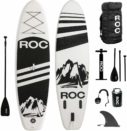Winter tends to discourage people from getting on the water, but that doesn’t have to be the case. There are several options for paddling in the colder months, depending on your skill and the likelihood of going in the water. There are also plenty of options when it comes to what clothes to wear to protect yourself from the harsh cold of winter.
Footwear
A pair of wetsuit booties is the warmest option — look for thick neoprene and snug, cozy lining. It won’t matter if you get slightly wet feet – the water will warm up inside and keep your toes warm and comfortable. If you can guarantee to keep your feet dry, a pair of hiking socks and trainers will also be warm. Get them wet though, and you’ll feel it. A nice compromise might be something like SealSkin socks over your hiking socks, and under your shoes.
Wetsuits
Wetsuits are designed to keep you warm when you’re wet. They trap a layer of water between you and the suit that warms up over time. They’re great if your surfing and immersed in the water but less so if you’re stood on a paddleboard in the wind. Sweat is also a problem in wetsuits. If you plan to paddle pretty hard, you’re going to sweat. When the sweat chills, you’re in danger of getting pretty cold.
That said, if you’re taking it easy, you’re unsure whether you’re going to stay dry, or you want the reassurance that you won’t freeze if you do fall in, a wetsuit could be the best option for you. We suggest pairing it with a windproof jacket to keep the chill off when you’re standing up. If you’re still cold, a thin polypro thermal layer under your suit will help.
Dry Suits
A dry suit is a waterproof suit with rubber seals at the wrists and neck to keep the water out. You wear thermal layers in the same way as you would if you were hiking. The advantage is that you’ll stay 100% dry if you fall in the water. The disadvantage is that unless it’s freezing outside, you’ll probably be far too warm as the suits tend not to breathe very well.
Jacket and Trousers
If you’re you’re seriously getting into paddle boarding and want to paddle flatwater year-round; we recommend getting hold of a waterproof jacket, waterproof trousers, and a few polypro thermal layers. The key to being active outdoors in the winter is the ability to add and remove layers as you need to — and so avoiding sweating.
If you’re on a budget, your rain jacket and trousers combined with some good thermal layers will work perfectly well. Just remember to wash them out properly afterward if you take them on salty water. The major disadvantage of this set up is that you’re going to get pretty cold if you do take a swim. Consider a few dry layers in a dry bag and a buoyancy aid for added reassurance.





